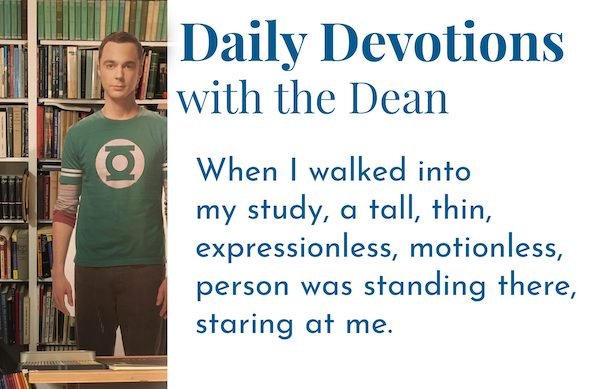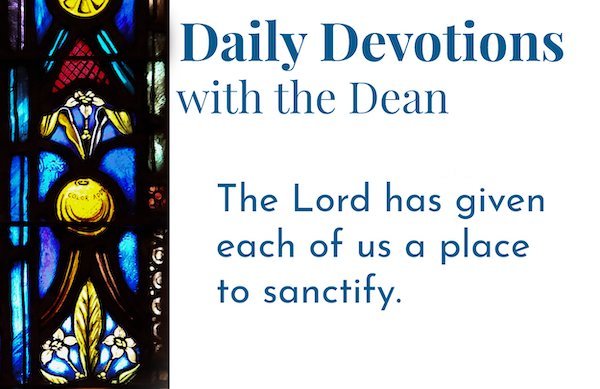Thursday • 1/18/2024 •
Thursday of 2 Epiphany, Year Two
This morning’s Scriptures are: Psalm 37; Genesis 11:1–9; Hebrews 6:13–20; John 4:1–15
This morning’s Canticles are: following the OT reading, Canticle 8 (“The Song of Moses,” Exodus 15, BCP, p. 85); following the Epistle reading, Canticle 19 (“The Song of the Redeemed,” Revelation 15:3–4, BCP, p. 94)
Welcome to Daily Office Devotions, where every Monday through Friday we consider some aspect of that day’s Scripture readings, as given in the Book of Common Prayer. I’m Reggie Kidd, and I’m grateful to be with you this Thursday in the Season After Epiphany. Our readings come from Year 2 in the Daily Office Lectionary.
The Tower of Babel: the nadir of primeval history. Throughout the story of human origins in Genesis 1–11, God’s severe judgments are accompanied by merciful grace. Adam and Eve are expelled from the Garden; but they are nonetheless graciously allowed to live, they are clothed, and are even promised that their seed will bruise their tempter’s head (Genesis 3:16). Cain is cursed for murdering his brother and is banished from Yahweh’s presence, becoming a “vagrant and wanderer on the earth.” And yet, surprisingly and graciously, Yahweh protects his life (Genesis 4:14–16). The washing away of wickedness in the flood in Noah’s day is followed by an olive leaf of hope, a rainbow of divine reconciliation, and the covenant of a new start for humanity (Genesis 6–9).
Genesis 11’s story of the Tower of Babel marks the culmination of primordial history. This story ends on a decidedly bleak note: “Therefore it was called Babel, because there the Lord confused the language of all the earth; and from there the Lord scattered them abroad over the face of all the earth” (Genesis 11:9). If there’s any grace here, it lies only in the fact that the divinely imposed confusion and scattering prevent humans from magnifying the error of their ways.
We receive this huge lesson from the Bible’s account of human origins: left to ourselves after the Fall, we would either destroy ourselves and each other (Cain versus Abel) or we would recapitulate the fundamental error of Adam and Eve in the Garden by coming together in a horrible conspiracy to try to make ourselves equal to God. That would be the universal human story … if Genesis 11 were the end of the story.
But it’s not the end of the story. Stay tuned for tomorrow’s introduction of the singular family, Abram’s, through which God’s grace and mercy re-engage the human situation. Through Abram, God promises to bring good out of evil, redemption out of captivity, unity out of enmity, clarity out of confusion, and beauty out of chaos—and all this, for all the world.
In the end, the Bible’s world is a world of promise and of love—a promise of redemption for a broken humanity, and a love that reunifies a scattered humanity.
Image: Thomas Virnich: Turm zu Babel, 2002 in Mönchengladbach/Germany
Fotograf: Hans Peter Schaefer
The original uploader was Hps-poll at German Wikipedia., CC BY-SA 3.0, via Wikimedia Commons
Hebrews 6: hope as an anchor for the soul. The writer to the Hebrews presents the summit of God’s promises. Those promises go all the way back to Genesis: that the seed of the woman will bruise the head of the serpent, that never again will there be a world-destroying flood, and that all nations will be blessed by one obscure Ancient Near Eastern family (Genesis 3,9,12).
For the writer to the Hebrews, the various promises of the Old Testament culminate in the coming of Jesus Christ (Hebrews 1:1–4). The grace that comes with his once-for-all sacrifice and with his ongoing heavenly ministry is so sure that the writer to the Hebrews says wavering souls can have a firm anchor: “We have this hope, a sure and steadfast anchor of the soul, a hope that enters the inner shrine behind the curtain, where Jesus, a forerunner on our behalf, has entered…” (Hebrews 6:19–20a). We have God’s word on it, sealed by the blood of Jesus and by the certainty of his resurrection. I pray we can hold onto that surety through all the turbulence of our lives.
John 4: let the regathering begin. Most of us are likely familiar with the gorgeous story of Jesus’s encounter with the woman at the well in Samaria. Jesus crosses multiple social barriers and violates various ethnic, moral, and cultural taboos to engage this “fallen” woman. She’s living with her fifth “husband,” to whom she’s not even married. It’s generally considered that her scandalous reputation (even among people who themselves are considered corrupt by faithful Jews!) is what has her at the village well alone in the heat of the day rather than in the company of the other women of the village in the cool of the morning.
Jesus’s conversation with her begins with the ordinarily casual matter of a drink of water, but quickly goes to the “the deep end of the pool”: her morally impossible situation, and the God who seeks lost people just like her and her fellow heterodox Samaritans.
The Tower of Babel narrative recounts the loss of the clear meaning of words as a punishing means of scattering people in confusion. Here in John 4, by contrast, Jesus employs misdirection (“give me a drink” … “bring me your husband”) and double entendre (“The water that I will give will become in them a spring of water gushing up to eternal life”) in a gloriously redemptive and salvific way. Here complexity of communication becomes a blessing not a curse, a means of evoking faith not of confounding.
In Jesus’s hands, density of language and wordplay unite people instead of dividing them. “He told me everything I’ve ever done,” she tells fellow villagers, “He couldn’t be the Messiah could he?” And with such irony-rich words, this woman of questionable moral character and, as a Samaritan, a decidedly impure bloodline, becomes the first missionary in John’s Gospel. Grace has taken the field, putting the curse of the Tower of Babel into reverse.
Be blessed this day,
Reggie Kidd+

















